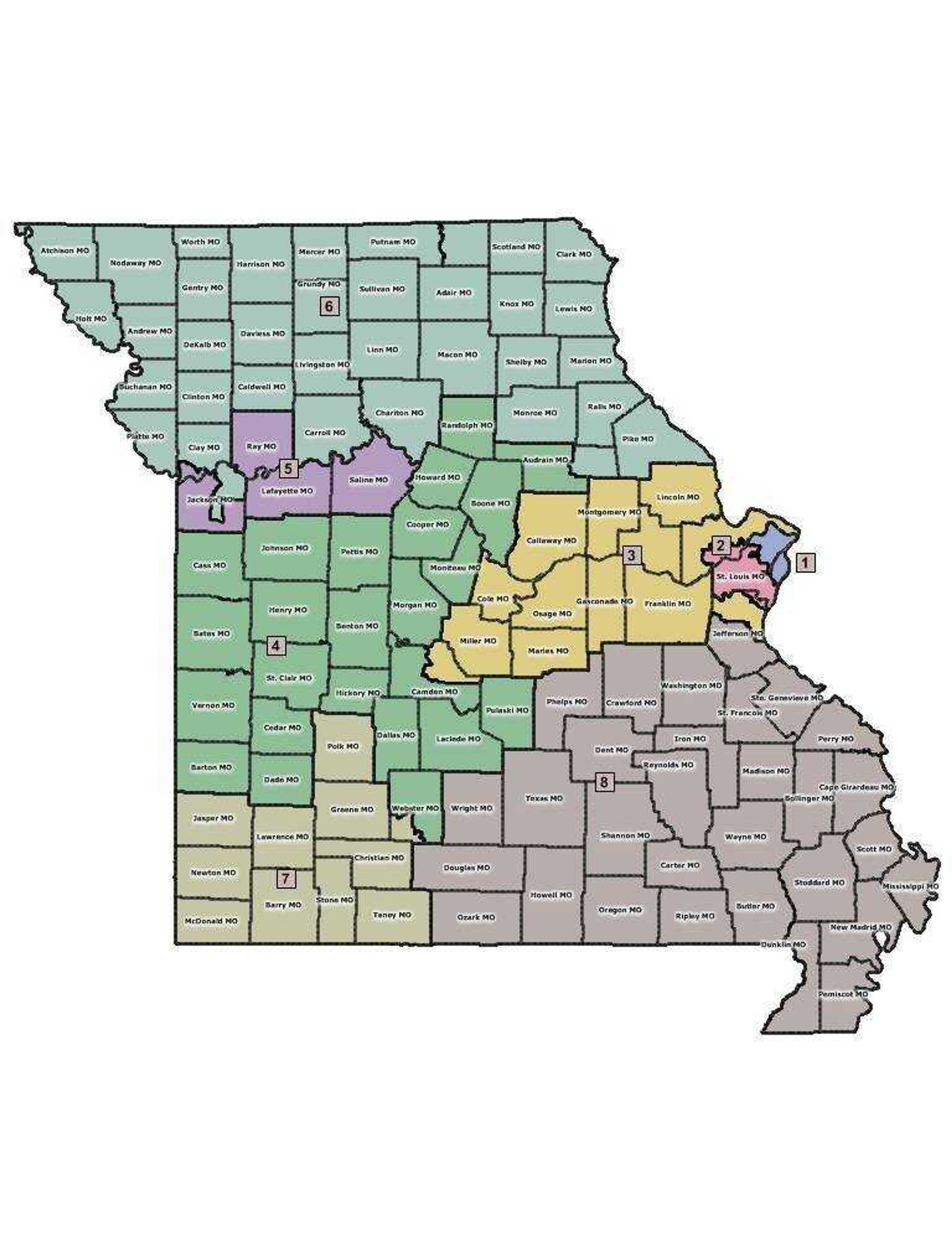Mo. high court upholds new congressional districts
JEFFERSON CITY, Mo. -- The Missouri Supreme Court upheld the state's new congressional districts Friday, solidifying a Democratic primary fight between two St. Louis congressmen and providing certainty for candidates who weren't sure which neighborhoods would be in their territories for the August primary elections...
JEFFERSON CITY, Mo. -- The Missouri Supreme Court upheld the state's new congressional districts Friday, solidifying a Democratic primary fight between two St. Louis congressmen and providing certainty for candidates who weren't sure which neighborhoods would be in their territories for the August primary elections.
A divided high court ruled Friday that Missouri's eight new U.S. House districts comply with a constitutional requirement to be "as compact ... as may be." The ruling affirms boundaries enacted last year when the Republican-led legislature -- with the help of a few Democrats -- overrode a veto by Democratic Gov. Jay Nixon.
Although some Supreme Court judges dissented, a majority determined that the Missouri Constitution "does not require absolute precision in compactness." The Supreme Court ultimately deferred to a February decision by Cole County Circuit Judge Dan Green, declaring that it was not going to substitute its own judgment for the trial court's when it came to disputed factual issues about the boundaries.
Missouri lawmakers had to redraw the state's nine current congressional districts into eight new districts after the 2010 census, because Missouri's population growth lagged behind that of some other states. The new congressional district map also had to account for population shifts within the state, such as a continued exodus of residents from St. Louis to its outer suburbs.
The new map triggered a Democratic primary in the 1st District in St. Louis between U.S. Reps. William Lacy Clay and Russ Carnahan, whose current district was split into several pieces.
On Friday, Carnahan accused Clay of striking a deal with state Republicans last year in an "attempt to keep a politically comfortable seat for himself" that resulted in fewer overall St. Louis-centered and Democratic-leaning districts.
"What this means is that for the next decade we are now stuck with the badly gerrymandered districts that needlessly divide our communities into bizarre animal-shaped districts," Carnahan said.
Clay did not immediately respond to a request for comment Friday but has previously expressed satisfaction with his redrawn district and confidence that he would defeat Carnahan in the primary.
One of the sponsors of the legislation creating the new congressional districts praised the Supreme Court ruling.
"It was a long and tortured process, but at the end of the day, the map that was passed by the General Assembly was constitutional," said state Rep. John Diehl, R-Town and Country.
Two separate lawsuits challenged the new map. One focused largely on the Kansas City area, where the 5th District was extended from Jackson County to also cover rural Lafayette, Ray and Saline counties -- forming a shape that some said resembled a "dead lizard." A tear-drop chunk of Jackson County, meanwhile, was carved out and added to the 6th District, which stretches across northern Missouri from Nebraska to Illinois.
In addition to the Kansas City area, the other lawsuit targeted the new 3rd District, which runs from central Missouri eastward with arms touching the Mississippi River both north and south of St. Louis. Some called that district "the lobster claw."
All seven judges agreed that the 3rd District met constitutional standards. They said the lobster-claw shape was a ripple effect of crafting a 1st District in St. Louis that complied with the federal Voting Rights Act by concentrating a large number of racial minority residents within the district.
But the court was divided over the Kansas City area districts.
The majority opinion upholding the districts bore no author's name but was backed by Supreme Court judges Patricia Breckenridge and Zel Fischer and appeals court judges Gary Lynch and Karen King Mitchell, who heard the case in place of recused high court judges Richard Teitelman and George Draper III.
Their ruling said the requirement that a district be compact "does not refer solely to physical shape or size" and allows for "minimal and practical deviations" resulting from other factors. Those other influencing factors include requirements for equal populations and contiguous areas, federal laws such as the Voting Rights Act, city boundaries and the dividing lines used for previous congressional district maps.
Ultimately, the majority coalition acknowledged there was a legitimate factual dispute about whether the 5th and 6th districts were as compact as could be, but it said it would not second-guess the trial judge who heard that evidence.
Judge William Ray Price Jr. wrote a dissenting opinion backed by Judge Laura Denvir Stith and appeals court Judge Joseph Ellis, who heard the case in the place of recused Supreme Court Judge Mary Russell. Price objected to the majority's decision to consider non-constitutional factors alongside the compactness requirement. He noted that the "teardrop-shaped oddity" protruding from the 6th District essentially moved 79,818 residents out of what otherwise would have been the 5th District and replaced them with 80,245 residents who otherwise could have been in the 6th District.
"Abstract discussion of law cannot mask the obvious fact that the legislature has attempted to gerrymander a teardrop-shaped portion of Jackson County from district 5 and place it in district 6," Price wrote.
Connect with the Southeast Missourian Newsroom:
For corrections to this story or other insights for the editor, click here. To submit a letter to the editor, click here. To learn about the Southeast Missourian’s AI Policy, click here.










